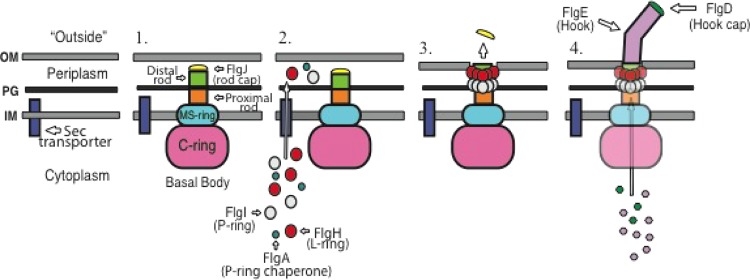FIG 1.

Model for the PL-ring-mediated switch from rod to hook polymerization during flagellar morphogenesis. The assembly of the flagellum is a hierarchical process. (Step 1) The first structures to assemble are the MS-ring in the inner membrane (IM) and the cytoplasmic C-ring. The inner membrane components of the flagellar T3S system are believed to assemble within the MS-ring, while the cytoplasmic components of the flagellar T3S system associate with the C-ring. The first secreted subunits to assemble are FliE, FlgB, FlgC, and FlgF, which form the proximal rod. FlgJ, the rod scaffold, associates with the rod at some point during this process in order to form a hole in the cell wall. FlgG polymerizes to form the distal rod on top of the proximal rod and underneath FlgJ. Distal rod assembly ceases once the rod has reached the outer membrane (OM), positioning the tip of the rod perpendicular to the outer membrane. PG, peptidoglycan. (Step 2) The subunits required for PL-ring formation, FlgA, FlgH, and FlgI, are secreted into the periplasm through the Sec secretion system. Once in the periplasm, FlgA assists FlgI in the assembly of the P-ring around the distal rod. FlgH forms the L-ring around the distal rod in close proximity to the P-ring. (Step 3) Formation of the L-ring around the distal rod by FlgH forms a pore in the outer membrane and also causes the rod scaffold, FlgJ, to dissociate from the tip of the distal rod into the extracellular environment. (Step 4) Once the rod cap has been dislodged from the rod, FlgD is able to form the hook scaffold and direct assembly of the hook by FlgE.
